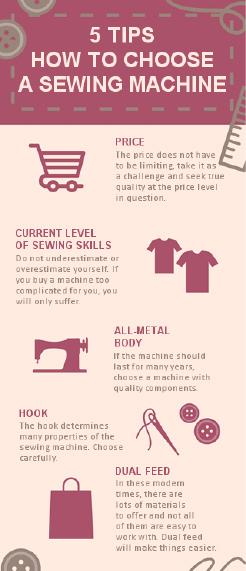For some time now, together with the boom of home sewing, there has been an increasing number of questions concerning the manner of choosing a sewing machine. There has been a lot of advice, however, questions of that type keep coming, so I decided to compile a few of my recommendations.
How to Choose a Sewing Machine?
Before we begin dealing with what the machines should and should not have, we must consider what we actually want to sew in the future, from what materials and how often. These 3 questions are extremely important in order to be able to choose the right machine for our needs.
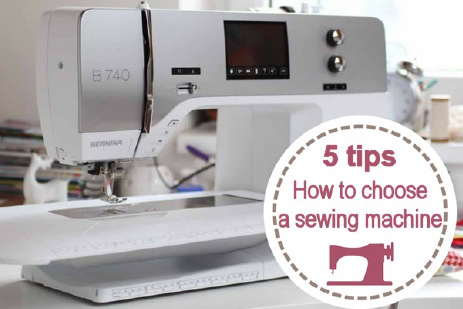
1. What Are You Going to Sew?
It is quite difficult to say at the beginning what exactly you will sew for the next few years or decades. But this question is really important. If you are drawn to patchwork, pillows, and accessories for the household, it is a completely different direction from e.g. sewing children clothes or classic ladies’ or men’s garments. Various kinds of products require different types of stitches (or machines) and a different overall approach to sewing. However, this does not mean that if you decide for something at the beginning, you can no longer change your mind. Just like a man, a creative activity and passion for something go through development, so it is completely possible that after a few months or years, you will need to focus on something a bit different and simply replace the machine with another one. It is unnecessary to perceive it as a major problem.
2. From What Will You Sew?
This is of course closely related to what will you sew. It is clear that if you will sew roofs and accessories for prams, you can absolutely forget about knitwear including overlock. If, for example, you will sew children’s clothes, knitwear, tracksuit fabrics, and flexible materials in general will by a priority, so you will eventually not be able to do without overlock.
3. How Often Will You Sew?
I probably don’t have to write an essay here. It is obvious that if somebody uses the machine daily, he or she will need a high-quality sewing machine and those who sew once a month at the weekend will do with an ordinary machine.
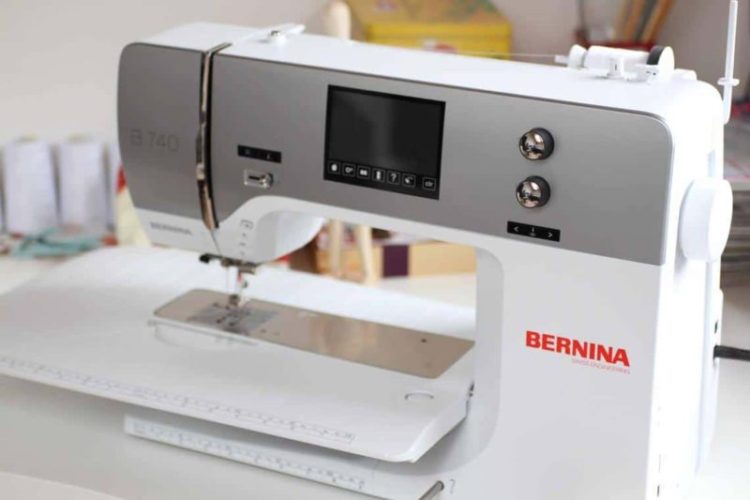
What Machine to Choose – 5 Tips
Recently, I’ve started comparing this topic to a parent teaching a child to ride a bicycle (or to ski or skate, it does not matter). When you want to teach a small child to ride a bike, you must get a bike that will be suitable for the child’s experience, height, and weight. A frequent error is that parents buy a larger bike for the children, thinking it will last long, maybe two or three years. When you take a three-year-old child, its height is on average 96 cm and weight 15 kg, and a child that is three years older is on average 25 cm taller and 7 kg heavier. It is logical that the small child will only suffer on a bike for the bigger kids. The bike will be too large and too heavy for a three-year-old, the kid will not properly reach the ground, it will be afraid of the height from the seat. How will such a beginner cyclist feel on such a new large bike? How will he or she like (or be stressed by) the learning and what progress will (or rather will not) he or she make?
Fortunately, there are bike rentals today, where you can borrow a bike for the season that will be suitable for the child’s height, weight, and experience…
1. Do Not Overestimate Your Capability
With a sewing machine, it is completely identical. If you never sewed anything and want to learn it well, correctly, and without unnecessary nerves, acquire a sewing machine that is really for beginners and be prepared to replace it with a better model in a few years. I often see a hobby sewer getting lured in the shop by a machine with a million functions, hundreds of stitches, etc. and then not being able to operate it at home. It is just like giving a small child a bike that is too large. The sewer, instead of learning how to sew straight, in arches, etc. actually struggles with operating the machine at all.
And then you can read the same questions like “hi handy, please give me advice on how to set the machine up” in various discussions over and over again. Well, I have simple advice for that, refer to your sewing machine’s manual - only that will give you the right answer because every machine is different and it is set up differently.
So, if you really want to learn to sew, I recommend getting a quality but simple machine without unnecessary advanced features at the beginning. The machine should be simple in terms of operation and maintenance. The more complicated the machine, the more extra work you will have when learning, increasing the number of opportunities to mess up things. You will not only learn the sewing technique but you will have to familiarise yourselves with all those functions of the machine in order to be able to use it at all.
2. Price of the Sewing Machine
The first criterion for decision-making is the price of the sewing machine, of course. Today, there is a huge variety of sewing machines in the market, so you can purchase a machine already from EUR 40 up to EUR 8000.
However, you must not forget that it all does not end with the purchase of the machine. It will certainly be needed to buy some sewing accessories, do not forget quality scissors (e.g. KAI), fabrics, threads, etc.
Before we move forward, please remember that it does not always pay to save. As I have already written in the article dedicated to sewing utilities that you cannot buy at the haberdasher: 5 sewing utilities that you cannot buy at the haberdasher, cheap low-quality machines, unfortunately, do not have a good design of the sealing around the stitch board and the hook. Therefore, the machines are clogged with dust and thread residues much more quickly. These machines must be cleaned more often and thoroughly (and cleaning is mostly also more difficult), that is why these machines are also much more often faulty… Cheap machines also mostly have a problem with regular threads, with which they refuse sewing at all or the threads get matted.
To sum it all up purchasing the cheapest machine possible “at any cost” means having to count with higher costs related to the maintenance and operation of the sewing machine in general.
Therefore, if you have considered the machine’s price, you can take a look at what should influence your decision further.
3. The body of the Sewing Machine
I am a supporter of all-metal machines. An all-metal machine means the inside of the machine – what we would see after removing the top plastic cover. Logically, of course, not everything inside the machine may be metallic, such as the belt. There are machine components that are specific in some ways and must, therefore, be made of various other materials. But most parts inside the machine may be made of quality metal that is not susceptible to rapid wear.
If the manufacturer of the machines replaces some of these parts with cheaper plastic parts, the machine will never last for as many years as the all-metal one. Plastic may break after some time and it is susceptible to overheating and deformation. You can find many people with good experience with ordinary machines that are half-plastic inside. However, you can also find many people who don’t have any good experience with such machines. On the other hand, you would find it difficult to find someone with a bad experience with an all-metal sewing machine. Frequent servicing of the machine costs a lot of money, not mentioning the fact that some machine parts can’t be repaired or replaced at all and that’s the end.
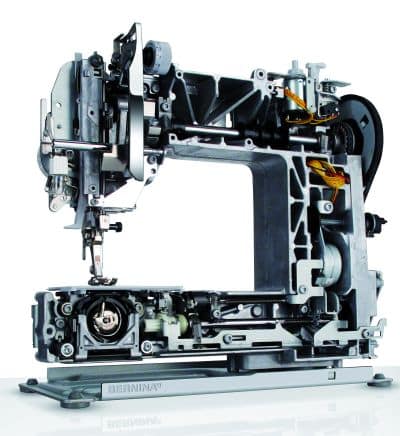
I recommend an all-metal body of the machine for absolutely everybody, be it beginners, intermediates, or professionals.
For me, it is the single most important thing to consider when buying a machine.
For example, take a look at the inside of a Bernina machine, stripped to the bone. It is clear that everything must work very well inside the machine. I think it is a beautiful all-metal work… I also have a Bernina machine at home that I am totally happy with. The higher models have quality motors and bodies from the manufacturer, like in industrial machines. Of course, the price is higher accordingly. On the other hand, home sewing machines of this type are essentially immortal, which is very special these days. ?
4. Hook
The sewing machine has just one single purpose, namely to sew two (or more) fabrics together. This is done using the upper thread that you lead from the reel and the lower thread that is wound on a bobbin. The bobbin is placed in the bobbin case that you insert into the hook. The hook has the task of leading the lower thread and intertwining it with the upper thread.
We have two basic types of hooks: oscillating (CB) and rotary. The third type you can occasionally encounter and that e.g. my sewing machine Bernina 740 has, is a vertical rotary hook used in industrial machines and high-quality home machines.
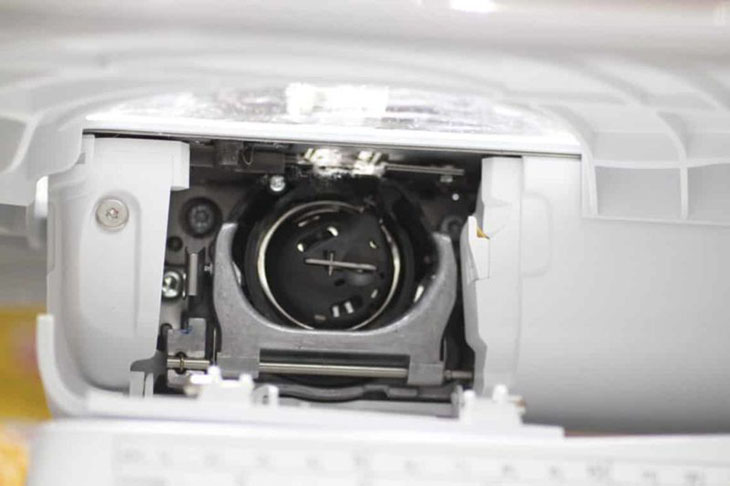
Oscillating Hook – Advantages and Disadvantages
Oscillating hooks were essentially used in all home machines until recently because (vertical) rotary hooks were only put into industrial machines. To understand the function of the oscillating or CB hook, you can watch this video:
Disadvantages of sewing machines with an oscillating hook:
- An oscillating hook swings from side to side. Therefore, it is needed for every stitch that the oscillating hook always returns. So, machines with this type of a hook are a bit slower than machines with a rotary hook.
- The oscillations of the hook from side to side also create slight vibrations and sewers often feel the machine skipping around on the table at higher revolutions.
- Machines with an oscillating hook are also a bit noisier.
- The stitch width of machines with an oscillating hook is always 5 mm, thus e.g. the width of a zigzag stitch will be max. 5 mm, however, that is a standard width, so it isn’t a major disadvantage and unless you sew really professionally with ornamental stitches, you can completely dismiss this.
Advantages of sewing machines with an oscillating hook:
- Machines with an oscillating hook have a very simple operation concerning the thread tension adjustment. You can simply regulate the lower thread tension using a screw on the bobbin case.
- Sewing machines with an oscillating hook are simpler to maintain, more durable, and therefore also less mechanically faulty.
- Sewing machines with an oscillating hook are not susceptible to “maladjustment” when sewing various materials. With a slight hyperbole, you can sew a curtain and immediately a softshell and, besides a minor modification of the upper thread tension, you will probably not have to set up anything else.
- Therefore, I generally recommend sewing machines with an oscillating hook as an obvious choice for complete beginners. As I have already written in the introduction, you should learn the sewing technique at the beginning and not worry about too many functions and a complicated machine setup.
- Due to the steadiness and quality of the stitch, sewing machines with an oscillating hook are suitable for sewing heavier materials, such as denim, artificial leather, etc.
Horizontal Rotary Hook – Advantages and Disadvantages
You can watch the function of the rotary hook here:
As you can see in the video, the bobbin is placed in a bobbin case inside the rotary hook that keeps turning (rotating) around. This results in several clear advantages. Machines with a rotary hook also have some disadvantages…
Disadvantages of a Sewing Machine with a Horizontal Rotary Hook:
- The bobbin very often jumps out of the bobbin case and the lower thread is thus entangled, making it necessary to stop sewing often, disentangle everything and insert the bobbin back into the case.
- Home sewing machines with a rotary hook are very sensitive to the quality of the used threads, mostly you have to use only really high-quality threads, such as Amann, Hagal, or Gütermann. Regular or e.g. special denim or linen threads are unfortunately not friends with these machines and get on your nerves most of the time.
- Sewing machines with a rotary hook are also very sensitive to various types of materials, therefore, be prepared to have to adjust and fine-tune the setup of the upper or even also the lower thread constantly when sewing various fabrics. Occasionally, it happens that even after long sewing of the same material, it will be necessary to tune the setup again after some time because the machine gets slightly maladjusted on its own.
- Cheaper machines with a horizontal rotary hook unfortunately frequently have problems with the thread getting stuck around the bobbin case and the hook, leading to unpleasant thread entanglement.
Advantages of a Sewing Machine with a Horizontal Rotary Hook:
- Sewing machines with a rotary hook are a bit faster than sewing machines with an oscillating hook thanks to their design.
- Home sewing machines with a rotary hook are also a bit quieter and mostly do not jump around on the table much.
- The bobbin is usually put horizontally in the machine under a transparent part of the stitch board, allowing for checking the quantity of the remaining thread wound on the bobbin.
- Sewing machines with a rotary hook also allow for further functions with the machines, such as automatic cut-off of the lower and upper thread at the end of sewing.
- Sewing machines with a rotary hook have a possibility of wide and decorative stitches and may offer a larger number of sewing stitches in general (however, the question is whether you can actually utilize all of them?).
A small summary concerning the hooks:
For complete beginners, I truly warmly recommend machines with an oscillating hook, they are more durable, so even an inexperienced sewer cannot inadvertently detune or damage the machine. Moreover, the machines have simpler maintenance, fewer failures, and various settings are very easy to perform with them during sewing.
If you are purchasing a machine for an experienced sewer who can already sew and just seeks a more powerful and creative machine, then you can surely buy a machine with a horizontal rotary hook that offers a higher number of stitches and other auxiliary tools, such as needle positioning or automatic thread cut-off, etc. It is needed to remember that the sewer should really be able to sew already so that it is no problem for her to tune various machine settings for different types of fabrics and clothes.
If you are buying a machine for a true professional or enthusiast, I, from my own experience, warmly recommend machines with a vertical rotary hook – that combines the advantages of the horizontal rotary hook and the oscillating hook and I have not found a disadvantage in the time of using such a machine yet. A disadvantage might only be the purchasing price of such a machine because vertical rotary hooks are only put into professional home machines or industrial machines.
If you browse through the offering of sewing machines, don’t be fooled by the fact that machines with an oscillating hook are cheaper. It absolutely does not mean they are worse or of lower quality, it just means they are simpler concerning operation and maintenance and e.g. do not have as many stitches.
5. Dual Feed
Most sewers encounter various materials in their sewing. Different fabrics also behave differently under the needle and the foot. Some fabrics tend to slip (tulle, satin, etc.), others are elastic and get deformed under the foot (cotton and viscose knitwear, etc.), others tend to not move under the foot (denim, artificial leather, etc.). So, if you do not sew from 100% cotton canvas only, you will certainly encounter the need for dual feed. What exactly does that mean?
When you look at a stitch board closely, you can find small teeth under the foot. These teeth are called the drop feed and do what the name says. It feeds the lower layer of the fabric under the foot. Thanks to these teeth, the fabric is shifted rearwards under the foot. However, if you are sewing any tougher material, such as denim, then it may happen to you that the lower layer of the fabric will nicely move rearwards but the upper layer of the fabric will be held by the foot and shoved in front of it.
Or you are sewing knitwear and the teeth try to move it under the foot and the foot presses the fabric too much, making the fabric wavy during sewing, making it impossible to do something about it.
Or (e.g.) you are sewing a satin skirt and feel that the drop feed does not work at all, the fabric does not move a lot and it all makes you angry.
There is a simple solution to all these problems – dual feed. You can either buy an additional upper feed or the so-called walking foot.
Additional Upper Feed
The dual feed also has teeth and you can simply put it on behind the foot. During sewing, the fabric is then shifted both using the drop feed (teeth under the foot) and the upper additional feed.
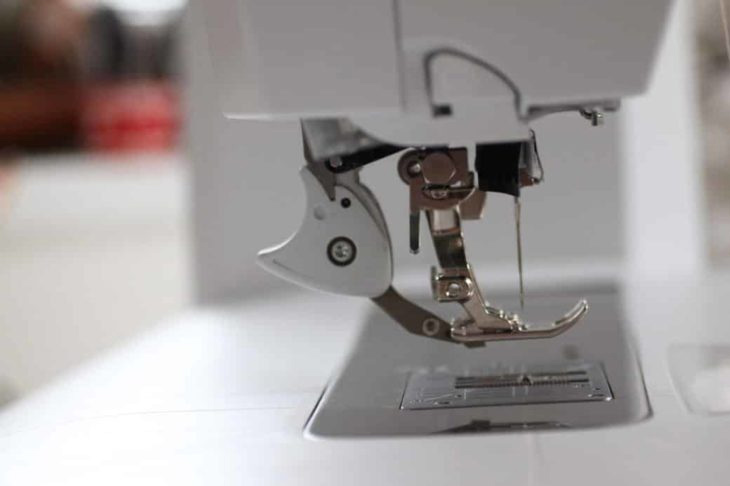
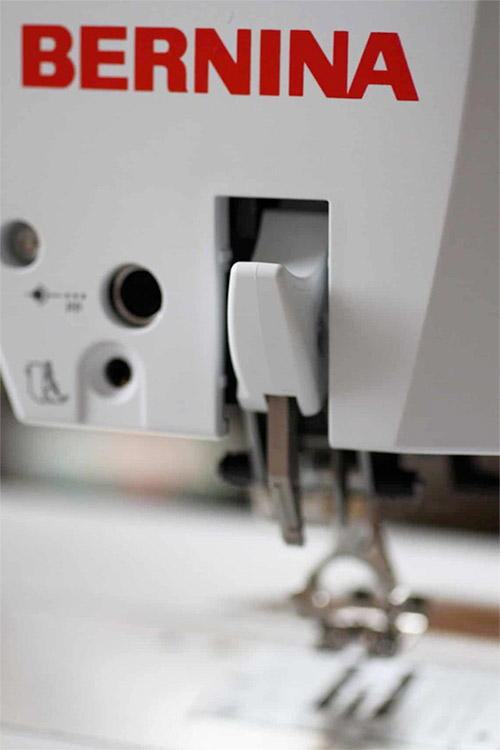
Walking Foot
Or you can buy the so-called walking foot for the machine. You will simply replace the classic one with it.
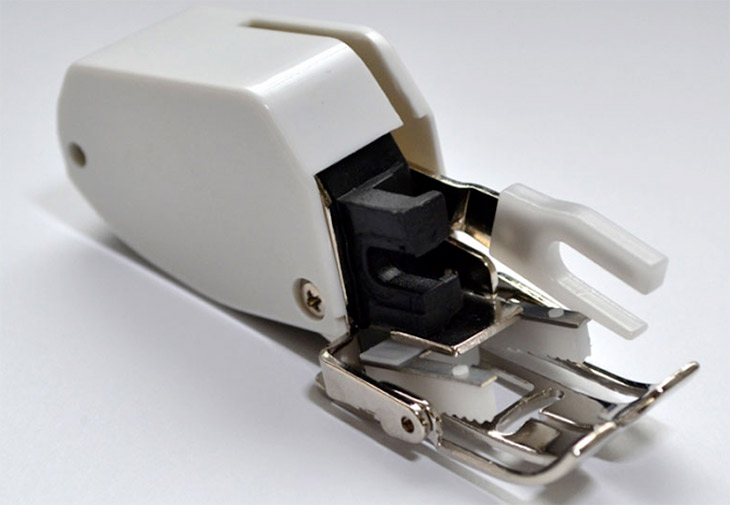
As you can see in the figure, there are paws along the foot that also have teeth and thanks to them the fabric is also shifted from above, causing even movement of both fabric layers resulting in a higher quality stitch.
Conclusion
I think it was relatively exhaustive for today. In a conclusion, I would like to remind you that a sewing machine is like a bicycle. If you want to learn biking, you will probably buy a quality yet simple bike. And once you master riding a bike, you can move forward and purchase a more advanced model. It is the same with sewing machines. When you are starting or are not absolutely confident about sewing, choose quality albeit simpler machines concerning operation and maintenance. And once you feel you are really proficient in the actual sewing, then consider the various modern conveniences of today. You should never and I emphasize never choose quantity over quality between a low-quality machine luring you with a large number of stitches and a quality machine that looks ordinary at the first glance. It really does not pay and you will just suffer unnecessarily.
I also certainly recommend visiting several shops specialized in selling sewing machines when choosing a sewing machine and ask them to demonstrate the machines for you. Take your time and carefully consider and try out what really suits you. The fact that something suits the saleswoman, that somebody made a beautiful photo of a machine and created nice advertising for it or that women praise a machine in the sewing group on facebook does not have to mean a lot. We are all different and everybody really finds different things suitable…
Just one last remark, I really recommend buying a machine in a shop specialized in selling sewing machines and not in a supermarket. The fact that you do not have such a shop in your town should not be an obstacle. A sewing machine is not a toy for a few coins and if you do not want to make a mistake when choosing a machine, seek advice and also have them demonstrate the machine for you. Among other things, you can return to the shop at any time with any questions concerning the machine or accessories…
I hope this article has been beneficial not only for those currently choosing a sewing machine but also for others. Everything I have written in today’s article is based on my personal experience. Like with many things in life, there is no universal correct advice for selecting a sewing machine that would be suitable for everyone…
And at some later point, we will take a look at what features I have learned to really appreciate in a machine (such as the knee lever or automatic overcasting, etc.).
Have a great time, Peťa
